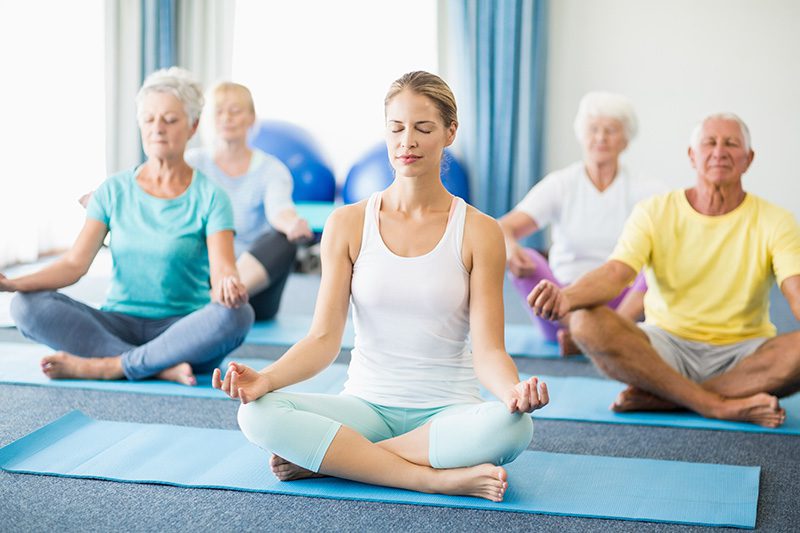Has your doctor talked with you about the benefits of exercise?
Exercise is not simply for weight management. Lifestyle interventions are very effective for reducing likelihood of chronic diseases, such as depression and anxiety, high blood pressure, type 2 diabetes, obesity, and osteoporosis. In fact, the Canadian Heart and Stroke Foundation suggests that adults who meet the recommended activity levels can reduce risk of premature heart disease, stroke and other chronic disease by as much as 80 per cent. (1) There is no doubt that this far exceeds the benefits of medications, yet convincing people to incorporate exercise into their daily routines is not an easy task.
The Canadian Physical Activity Guidelines (2) recommend that adults accumulate at least 150 minutes of moderate-to-vigorous exercise each week. This can be done in sessions of 10 minutes at a time, keeping it manageable while still providing health benefits. Adding strength exercises a couple days a week can increase the benefits. Despite this, according to Statistics Canada, fewer than 25% of Canadian adults achieve this level of physical activity. (3) And only about half of people who start an exercise program stick with it for more than six months.
What keeps you from engaging in physical activity?
For many people, lack of time for exercise is a significant barrier. Keep in mind that it’s not necessary to exercise for 30 minutes at a time. You might find it easier to exercise for shorter periods of time both before and after work. Or you might go for a walk on your lunch break. Stretching exercises or yoga may be a great way to wind down at the end of the day and prepare for a more restful sleep.
Exercising does not have to cost a lot. You don’t need a gym membership or expensive equipment. A good pair of shoes is all you need to enjoy a healthy walk outdoors. You might consider purchasing a pair of Nordic walking poles. Nordic walking engages both upper and lower body muscles for a more complete workout. For individuals with posture, gait or balance issues, using the poles can improve speed and reduce risk of falls. In a small study carried out by the Ottawa Heart institute, individuals who were part of a supervised Nordic walking group showed improvements in both physical and mental health that continued beyond the 6-month trial. (4) A set of resistance bands can be used for simple, at-home exercises to increase strength, or you can do exercises that use your own body weight for resistance.
If you’ve been sedentary for some time, or you’re recovering from surgery or a health condition, it is normal to feel hesitant to start an exercise program. It may help to discuss your concerns with your family doctor or a personal trainer. A trainer can use a screening tool called the PAR-Q (Physical Activity Readiness Questionnaire) (5) — created by the BC Ministry of Health and the Multidisciplinary Board on Exercise — to assess the safety or risks of exercising based on health history, current symptoms, and risk factors. Your doctor can address any health risks that are identified.
What is a “Rx for exercise”?
A prescription for a medication outlines the details of the doctor’s recommendations: drug name, dose, how often to take the medication, and for how long. Similarly, a Rx for exercise outlines the types of exercise, how long to do the exercises, how frequently, and at what intensity. (6,7) For example, it might suggest walking for 10 minutes at a speed sufficient to get your heart rate to a certain level, and that this should be done five days per week. Your prescription may include both aerobic and resistance (strength) exercises. Aerobic exercises, such as walking or swimming, provide the most benefit in terms of cardiovascular health. Lean muscle mass decreases with age, mostly from lack of use, so strength training is important to improve physical function and reduce risk of injury. Also, it is less demanding on the heart, so is generally considered safe for individuals with various heart conditions. (7)
What is the best exercise?
Simply put, the best exercise is an activity that you like doing! Here are a few suggestions to encourage a more active lifestyle:
- Start by reducing your sedentary time – limit TV and computer time; set a reminder to get up and move at least once an hour.
- Choose active options when running errands – park further away from the grocery store, take the stairs instead of the elevator, walk the dog an extra couple blocks.
- Choose activities that you enjoy – if riding a stationary bike or walking continuously on a treadmill is boring, choose an outdoor activity instead.
- Make it a social experience – attend a group class or exercise with a friend.
- Add some music – change the rhythm to adjust the intensity of your workout.
- Wear an activity logger (e.g., Fitbit) – these gadgets monitor your steps, heart rate, sleep patterns, and more; you can even map your walking, hiking or cycling route.
- Mix it up – there are so many recreational opportunities, so add some variety to keep things interesting: aerobics, martial arts, tennis, bowling, cycling, swimming, fishing, kayaking, yoga.
- Activities at home and work – gardening and yard work, sweeping, stocking shelves, etc. also count as physical activities.
- Make your health a priority – add a scheduled exercise appointment to your daily calendar; this is your time!
Get motivated. Get moving.
Regular physical activity is one of the most important things you can do to improve your overall health. It may seem overwhelming, but you can do it! Just take it one step at a time.
